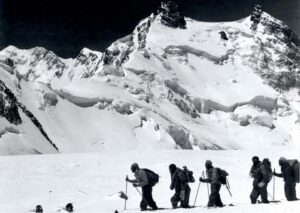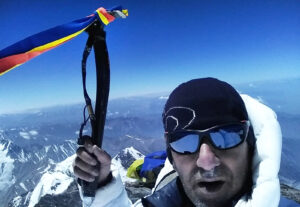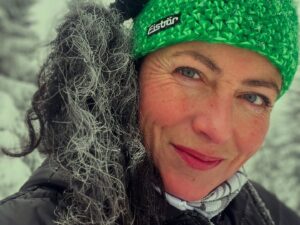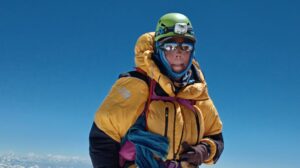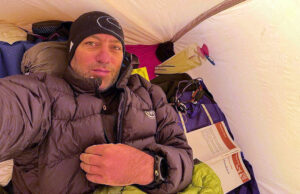With Simone Moro waiting out bad weather in Samagaon before resuming his winter climb on Manaslu, we seized the chance to ask the Italian about another ongoing expedition: the alpine-style attempt on Nanga Parbat’s Rupal Face by Herve Barmasse and David Gottler.
If someone knows that route and Nanga Parbat in winter, it’s Simone Moro. He also knows both climbers well. Moro attempted the Schell route with Gottler in 2014. Together, the pair made it above 7,000m. Moreover, that route eventually crosses the Mazeno Ridge through the so-called Mazeno Pass, toward the Diamir side of the mountain. It was from the Diamir side that Moro, current partner Alex Txikon, and the late Ali Sadpara made Nanga’s first winter ascent in February 2016.
“The Schell route is a really nice and logical line along the Rupal side of Nanga Parbat,” said Moro. “But it is a very, very long crossing from the Rupal side to the Diamir side in the most difficult section of the mountain and at the highest altitude.”
6,200m, then back to Base Camp
So far, Barmasse and Gottler have reached 6,200m, where they had a very cold bivy during a blizzard. They retreated back to Base Camp the following day. Sticking to the rules of alpine style, they took all their gear and tent with them. We asked Moro about that first part of the route, and what lies ahead for the climbers.

A very cold bivy at 6,200m for Barmasse and Gottler last week. Photo: David Gottler
“The section from BC till 6,200m is not extremely difficult technically but nor is it a simple walk, especially from 5,600m to the shoulder of the Schell ridge,” Moro explained. “Then it follows the upper ridge and the plateau that leads to the Mazeno Pass at 7,400m. To get there, we used an intermediate camp at 5,100m. Then we established Camp 2 in an ice cave by a big crevasse at 6,150 m. From that point, we were more exposed to the wind. We climbed to 6,700m, where we established our C3.”

Simone Moro at the snow cave at 6,150m in 2014. Photo: David Gottler
Upper sections unknown
However, Moro is not so sure about the upper sections on the mountain, especially since Barmasse and Gottler have opted for an alpine-style ascent.
“The Schell route is, in my opinion, a good option for an alpine-style climb in summer, but not so much in winter,” he said. “In fact, my friends Herve and David tried two other routes before opting for the Schell, which was not their original plan.”

During Moro’s 2014 winter attempt. photo: David Gottler
According to Moro, the reason that the Schell is less suitable in winter is that it’s the longest route. It requires a long, cold, and difficult traverse from the southern Rupal Face to the western Diamir side.
“That traverse is complex and requires more hours in the shade,” Moro said. “In case of a storm or physical problem, you might have to escape and descend via the opposite face [Diamir], where they have no base camp.”

Nanga Parbat’s summit area from the Diamir side. The lines show the summit push of the 2012 British team of Sandy Allan and Rick Allen, who reached the top via the Mazeno Ridge. The green, blue, and yellow lines are all part of the Schell route from Mazeno Pass. The yellow line shows the normal Kinshoffer route. Red crosses show Allan and Allen’s bivouacs.
Easiest but not easy
“So, although the Schell route is the easiest of the Rupal lines, it is actually very complex, especially from the Mazeno ridge to the summit, with no quick and easy escape,” said Moro. He points out that that route has been climbed only seven times in all.

Simone Moro climbs toward Mazeno Pass in 2014. Photo: David Gottler
“David only knows the route till the Mazeno col at 7,400-7,500m,” he says. “Then they enter unknown terrain. Neither Herve nor I have ever been there, either. I just saw the ridge from the summit of Nanga and it looked really impressive.
“They, of course, have the ability to climb quickly to the summit and back, but so far, nobody has climbed that upper section [Mazeno-summit-Mazeno] in one day up and down, not even in summer.”
Moro points out that before Txikon, Sadpara, and he succeeded, there had been 30 previous attempts. “That should mean something,” he said. “Now, to climb winter Nanga alpine style is for sure an evolution and a great achievement, but those do not always come quickly and easily.”

Simone Moro in C2 during the 2014 winter attempt on Nanga Parbat’s Rupal Face. Photo: David Gottler
To succeed, the stars must align
Still, Moro believes that their quest is possible. He cites the first winter climb of Makalu that he did with Denis Urubko. “Ours was the lightest winter ascent in history. There were just the two of us, and we established only a single camp at 6,700m before the alpine-style summit push.”
But for Barmasse and David to succeed, he concludes, they will need a good dose of luck with the weather and conditions. “Nanga Parbat is one of the biggest mountains on the planet and the risk is always great, but I trust my friends, so I’m not afraid, or at least, not more than usual.”

Descent from 6,200m in the fog, last week. Photo: Herve Barmasse
History of Schell Route climbs

Nanga Parbat’s Rupal Face. Photo: Simone Moro
Moro has listed those expeditions that made it above 7,000m on the Schell Route, with their rates of progress.
1) Hans Schell and team 1976
Day 1. Went from C3 to C4 at 7,450m
Day 2. Bivouacked at 7,700m
Day 3. Bivouacked at 8,020m
Day 4. Summit and down to C4 very late
2) Ronald Naar 1981
1. First bivouacked at 7,500m
2. Made a couple of wrong turns during their traverse to Diamir side and eventually bivouacked at 7,550m
3. Summit and down
3) Oscar Cadiach and Jordi Magrina 1984
1. Placed C4 at 7,500m
2. Traversed to Diamir side, bivouacked just beneath summit pyramid at 7,500m
3. Summit and back to bivouac (7,500m)
4. Bivouacked at 7,250m because of storm
5. C3 and down
4) Marija Frantar and Joze Rozman 1990
1. Crossed the ridge to Diamir side and bivouacked at 7,200m
2. Bivouacked at 7,500m
3. Summit and down
5) Reinmar Joswig and Peter Mezger 1990
1. Crossed the ridge to Diamir side and bivouacked at 7,100m
2. Bivouacked at 7,550
3. Spent the day trying to climb an ice couloir on the summit cone. Back to 7,550m bivouac at night
4. Summit and night in bivouac (7,550m)
5. Down to C4 at 7,100m on the Rupal side
6) Osamu Nakajima 1990
1. Began summit push from C4 (7,500m); bivouacked at 7,540m
2. Bivouacked at 7,720m
3. Summit and down to one of the bivouacs
4. Down to C4
7) Romanians 2013
1. Climbed to C5 at 7,300m
2. Traverse. Bivouacked at 7,300m-7,400m
3. Bivouacked at 7,500m
4. Summit and down to 7,500m
5. Down to C3

